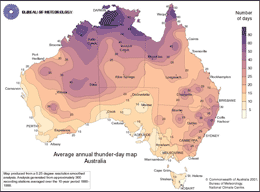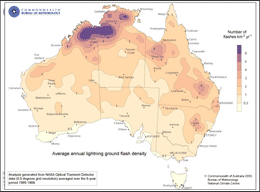Ignition sources
People are responsible for most of the fires that occur in northern Australia — prescribed fires, accidental fires and those started by arson. Fires are lit by a variety of land managers including the Bushfires Council, conservationists, traditional owners, rural block owners and pastoralists.
Activity: Natural ignition
What is the distribution of lightning strikes?
Lightning is also an important ignition source in parts of northern Australia.
Have a look at the maps that show the average annual thunder days. Which area receives the most lightning, and how much? How do you think this might vary seasonally, and what might this mean for the chance of fires?

Annual thunder days
An explanation of Annual thunder days is provided on the Bureau of Meteorology website.

Lightning ground flash intensity
An explanation of lightning ground flash intensity (pdf document).
Another ignition source, though much more unlikely, is rockfall. Sparks from falling rocks have been known to cause fires. Can you think of an area where this could potentially happen? The undercarriage of vehicles and heavy machinery scraping on rocks can also be a cause of fire ignition.
Activity: Seasonal significance of ignition sources
In which season is each ignition source likely to be most important?
Describe how various ignition sources might vary in their:
- seasonal timing
- frequency
- relative occurrence in different vegetation types
You could draw this up as a table (word document)